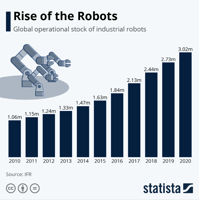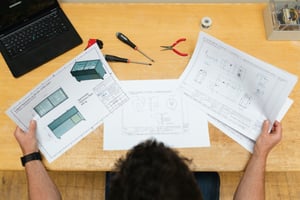From its beginning as a relatively simple machine to help people transport heavy equipment to the...
Smart Factories & Industry 4.0
The 4th industrial revolution, also known as Industry 4.0, refers to the current trend of automation and data exchange in manufacturing technologies, including the Internet of Things (IoT), artificial intelligence (AI), and cognitive computing. It is characterized by a fusion of technologies that blur the lines between the physical, digital, and biological spheres. The creation of “smart factories,” in which machines and systems can communicate and cooperate with each other, making the production process more efficient and flexible, is the primary goal. Smart factories blend several new technologies together, such as the Internet of Things (IoT), artificial intelligence (AI), and robotics, to create manufacturing processes that are more efficient, flexible, and adaptable.
The 4th industrial revolution is expected to bring significant changes to the way we live and work, and it is already having a profound impact on industries such as manufacturing, transportation, and healthcare.
Overall, robots will play a central role in the creation of smart factories, as they will be the backbone of the new manufacturing system and will greatly improve productivity, efficiency, and safety. They will be driven by ever improving artificial intelligence systems that has access to a vast amount of real time data that can be used to analyze the efficiency of manufacturing processes as well as the goods that are being produced. Advanced, internet enabled sensors will allow the system to detect machines that need maintenance well in advance and conduct such maintenance automatically, all while continuing the manufacturing processes 24x7.
Some of the key roles that robots will play in Industry 4.0 include:
- Automating repetitive and dangerous tasks, such as welding, painting, and assembly.
- Conducting precision tasks, such as quality control and inspection.
- Monitoring and maintaining equipment and facilities.
- Analyzing and processing large amounts of data from the production process.
- Collaborating with humans in a shared workspace.
The integration of AI and robots will lead to the development of smart robots, which are capable of making decisions based on real-time data and self-optimizing their performance. This will also lead to the development of autonomous systems that can operate independently with minimal human supervision, which will increase efficiency and reduce the need for human labor.
While Industry 4.0 has the potential to bring many benefits, such as increased efficiency, productivity, and flexibility, it also has some potential downsides that need to be considered.
Job displacement: One of the main downsides of Industry 4.0 is that it is expected to lead to job displacement, as machines and automation take over tasks that were previously done by humans. This could lead to a decline in employment opportunities in certain sectors, particularly in industries that rely heavily on manual labor.
Cybersecurity risks: The increased connectivity and automation of Industry 4.0 also means an increase in cybersecurity risks. As more machines and devices are connected to the internet, they become vulnerable to cyberattacks that could compromise the entire system.
Dependence on technology: Industry 4.0 also increases the dependence of companies on technology, which could be problematic if there are disruptions in the supply of technology or power.
Lack of skilled workforce: Industry 4.0 also requires specialized skills that not all employees may possess, and the shortage of a skilled workforce can be a downside for companies.
In conclusion, Industry 4.0, is a current trend that is characterized by the fusion of technologies that blur the lines between the physical, digital, and biological spheres. The primary goal of Industry 4.0 is to create "smart factories" that are more efficient, flexible, and adaptable through the integration of technologies such as the Internet of Things (IoT), artificial intelligence (AI), and robotics. Robots will play a central role in the creation of smart factories and will greatly improve productivity, efficiency, and safety. However, Industry 4.0 also has potential downsides such as job displacement, cybersecurity risks, dependence on technology, and lack of a skilled workforce. The implementation of Industry 4.0 will require a balance of its benefits and drawbacks and needs to be approached with caution.



